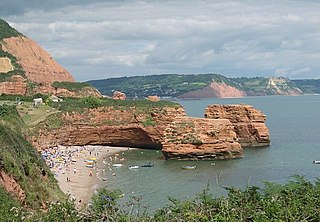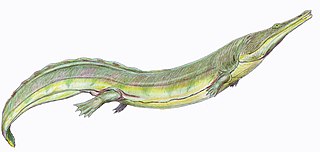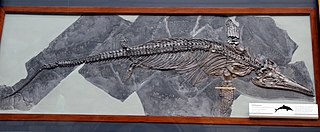
Therapsida is a major group of eupelycosaurian synapsids that includes mammals, their ancestors and relatives. Many of the traits today seen as unique to mammals had their origin within early therapsids, including limbs that were oriented more underneath the body, as opposed to the sprawling posture of many reptiles and salamanders.

Sauropodomorpha is an extinct clade of long-necked, herbivorous, saurischian dinosaurs that includes the sauropods and their ancestral relatives. Sauropods generally grew to very large sizes, had long necks and tails, were quadrupedal, and became the largest animals to ever walk the Earth. The "prosauropods", which preceded the sauropods, were smaller and were often able to walk on two legs. The sauropodomorphs were the dominant terrestrial herbivores throughout much of the Mesozoic Era, from their origins in the mid-Triassic until their decline and extinction at the end of the Cretaceous.
The Late Triassic is the third and final epoch of the Triassic Period in the geologic time scale, spanning the time between 237 Ma and 201.3 Ma. It is preceded by the Middle Triassic Epoch and followed by the Early Jurassic Epoch. The corresponding series of rock beds is known as the Upper Triassic. The Late Triassic is divided into the Carnian, Norian and Rhaetian Ages.

Liliensternus is an extinct genus of basal neotheropod dinosaur that lived approximately 210 million years ago during the latter part of the Triassic Period in what is now Germany. Liliensternus was a moderate-sized, bipedal, ground-dwelling carnivore, that could grow up to 5.15 m (16.9 ft) long. It is the best represented Triassic theropod from Europe and one of the largest known.

Therocephalia is an extinct suborder of eutheriodont therapsids from the Permian and Triassic. The therocephalians ("beast-heads") are named after their large skulls, which, along with the structure of their teeth, suggest that they were carnivores. Like other non-mammalian synapsids, therocephalians were once described as "mammal-like reptiles". Therocephalia is the group most closely related to the cynodonts, which gave rise to the mammals. This relationship takes evidence in a variety of skeletal features.

Ladram Bay is a secluded bay with a pebble beach, on the south coast of Devon, England between the coastal towns of Budleigh Salterton and Sidmouth. It is about 11 miles southeast of Exeter, just under 2 mi (3 km) southwest of Sidmouth and about 2+1⁄2 miles (4 km) northeast of Budleigh Salterton.

Trematosauroidea are an important group of Triassic temnospondyl amphibians. They flourished briefly during the Early Triassic, occurring worldwide before declining at the start of the Middle Triassic, although the group continued until the Late Triassic. They were medium-sized temnospondyls with wedge-shaped tails, narrow skulls, and, in advanced forms, elongated snouts. The latter feature was probably an adaptation for feeding on fish. The largest and most specialized family, the Trematosauridae, are the only batrachomorphs to have adapted to a marine lifestyle with the exception of the modern crab-eating frog.

Pistosaurus is an extinct genus of aquatic sauropterygian reptile closely related to plesiosaurs. Fossils have been found in France and Germany, and date to the Middle Triassic. It contains a single species, Pistosaurus longaevus. Pistosaurus is known as the oldest "subaquatic flying" reptile on earth.

Hindeodus is an extinct genus of conodonts in the family Anchignathodontidae. The generic name Hindeodus is a tribute to George Jennings Hinde, a British geologist and paleontologist from the 1800s and early 1900s. The suffix -odus typically describe's the animal's teeth, essentially making Hindeodus mean Hinde-teeth.

Proterochampsa is a genus of proterochampsid archosauromorph from the Late Triassic (Carnian) Cancha de Bochas Member of the Ischigualasto Formation in the Ischigualasto-Villa Unión Basin in northwestern Argentina and the Alemoa Member of the Santa Maria Formation in the Paraná Basin in southeastern Brazil. Average length of skull of P. barrionuevoi is approximately 50 centimetres (20 in).

Chigutisauridae is an extinct family of large temnospondyl amphibians. The only genera recognized as belonging to Chigutisauridae at the current time are all from Gondwana. Chigutisaurids first appeared during the Early Triassic in Australia. During the Late Triassic they became widely distributed in Gondwana, with fossils found in South Africa, India and South America. Koolasuchus from the Early Cretaceous of Australia represents the youngest known temnospondyl.

Compsocerops is an extinct genus of temnospondyl amphibians recovered from the Late Triassic Upper Maleri Formation of India, and the Santa Maria Formation of Brazil.

Broomistega is an extinct genus of temnospondyl amphibian in the family Rhinesuchidae. It is known from one species, Broomistega putterilli, which was named in 2000. Fossils are known from the Early Triassic Lystrosaurus Assemblage Zone of the Beaufort Group in the Karoo Basin of present-day South Africa, a region that had been an enclave of Gondwana. Specimens of B. putterilli were once thought to represent young individuals of another larger rhinesuchid such as Uranocentrodon, but the species is now regarded as a paedomorphic taxon, possessing the features of juvenile rhinesuchids into adulthood.
Menadon is an extinct genus of traversodontid cynodonts. The type and only species is Menadon besairiei.

Tanystropheidae is an extinct family of mostly marine archosauromorph reptiles that lived throughout the Triassic Period. They are characterized by their long, stiff necks formed from elongated cervical vertebrae with very long cervical ribs. Some tanystropheids such as Tanystropheus had necks that were several meters long, longer than the rest of their bodies.
Barasaurus is an extinct genus of owenettid procolophonoid parareptile known from the late Late Permian and early Early Triassic of Madagascar. It contains a single species, Barasaurus besairiei.
Sungeodon is an extinct genus of dicynodont therapsid from the Early Triassic of China. It is known from a single type species, Sungeodon kimkraemerae, which was named in 2014. Sungeodon is the earliest member of a group of dicynodonts called Kannemeyeriiformes, which would radiate later in the Triassic to become the dominant large herbivores of terrestrial ecosystems. Before its discovery no kannemeyeriiform dicynodonts were known from the Early Triassic. The presence of Sungeodon in the earliest Triassic Jiucaiyuan Formation indicates that dicynodonts diversified soon after the Permian-Triassic extinction event, mirroring the explosive radiations of other tetrapod groups such as archosaurs soon after the extinction.

The Ichthyosauromorpha are an extinct clade of marine reptiles consisting of the Ichthyosauriformes and the Hupehsuchia, living during the Mesozoic.
Eohyosaurus is an extinct genus of basal rhynchosaur known from the early Middle Triassic Burgersdorp Formation of Free State, South Africa. It contains a single species, Eohyosaurus wolvaardti.

Allokotosauria is a clade of early archosauromorph reptiles from the Middle to Late Triassic known from Asia, Africa, North America and Europe. Allokotosauria was first described and named when a new monophyletic grouping of specialized herbivorous archosauromorphs was recovered by Sterling J. Nesbitt, John J. Flynn, Adam C. Pritchard, J. Michael Parrish, Lovasoa Ranivoharimanana and André R. Wyss in 2015. The name Allokotosauria is derived from Greek meaning "strange reptiles" in reference to unexpected grouping of early archosauromorph with a high disparity of features typically associated with herbivory. Nesbitt et al. (2015) defined the group as a stem-based taxon containing Azendohsaurus madagaskarensis and Trilophosaurus buettneri and all taxa more closely related to them than to Tanystropheus longobardicus, Proterosuchus fergusi, Protorosaurus speneri or Rhynchosaurus articeps. Therefore, Allokotosauria includes the families Azendohsauridae and Trilophosauridae by definition, as well as the potentially more basal Pamelaria which is closer to them than to other early archosauromorphs. Pamelaria is the earliest known allokotosaur, dating to the Anisian of India. Azendohsauridae is currently represented by a single genus Azendohsaurus known from the Ladinian to Carnian of Africa, while trilophosaurids are mostly known from the Carnian to Norian stages of North America, England and potentially European Russia, though one member of the latter group, Variodens inopinatus, is known from Rhaetian. According to studies of Arctosaurus material from Cameron Island in Canada, the latter may have been an allokotosaurian because of the similarities with Azendohsaurus due to the presence of a posterior ridge from the centrum to the diapophyses which extends from the diapophysis all the way to the posterior ventrolateral corner of the centrum. This ridge overhangs a deep groove in the lateral surface of the centrum.














